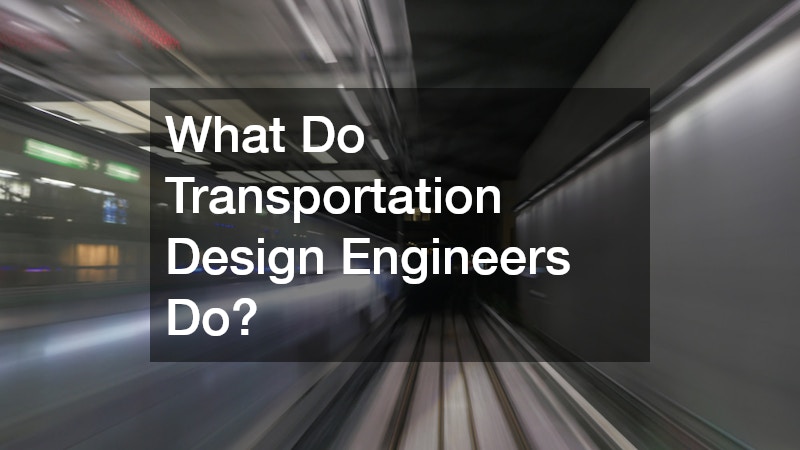Transportation design engineers play a crucial role in shaping the infrastructure that keeps cities and towns functioning smoothly. From designing highways to ensuring the safety of pedestrian pathways, these professionals are behind the planning and construction of the roads, bridges, and transit systems we use every day. But what exactly do transportation engineers do, and why are their roles so essential? Let’s take a closer look at the key responsibilities and contributions of these engineers.
Planning and Designing Transportation Systems
One of the primary roles of transportation design engineers is to plan and design transportation systems that meet the needs of growing populations. This includes creating blueprints for new roadways, bridges, tunnels, and transit systems that not only accommodate current traffic but also anticipate future demands. Their work requires a deep understanding of traffic flow, population growth, and land use to ensure that their designs can handle increasing numbers of vehicles and pedestrians safely and efficiently.
Transportation design engineers work closely with urban planners, government agencies, and environmental experts to develop plans that align with community goals and environmental regulations. They must balance the need for infrastructure development with the desire to minimize environmental impact, often incorporating green design elements like bike lanes, pedestrian-friendly walkways, and public transit access into their projects.
Ensuring Safety and Compliance
Safety is at the heart of every project transportation engineers undertake. Whether they’re designing a bridge or a new highway intersection, their job is to ensure that the infrastructure is safe for everyone who uses it. This means considering various factors such as visibility, speed limits, road curvature, and traffic signal placement to prevent accidents and ensure smooth traffic flow.
Moreover, transportation engineers must comply with local, state, and federal regulations regarding construction and road safety. These regulations often dictate specific standards for things like road width, materials used, and signage. Engineers must stay up to date on these guidelines to ensure that their projects meet all necessary safety and legal requirements.
Addressing Environmental Concerns
In addition to planning safe and efficient transportation systems, transportation engineers are also responsible for addressing environmental concerns. Infrastructure projects can have significant environmental impacts, from increasing carbon emissions to disrupting natural habitats. Engineers must conduct environmental impact assessments to evaluate how their projects will affect the surrounding environment and develop strategies to minimize negative consequences.
For example, when designing a new highway, engineers might consider using materials that reduce noise pollution or implementing drainage systems that prevent runoff from contaminating nearby waterways. They may also incorporate renewable energy sources, like solar-powered lighting, to make the transportation system more sustainable.
Project Management and Collaboration
Transportation design engineers are often involved in the project management aspects of infrastructure development. Once the design phase is complete, they oversee the implementation of their plans, coordinating with construction teams, contractors, and government agencies to ensure the project is completed on time and within budget.
This role requires strong leadership and communication skills, as engineers must collaborate with a wide range of professionals, from architects and surveyors to environmental scientists and city officials. Managing a large-scale transportation project often means addressing unexpected challenges, such as delays in material delivery or adverse weather conditions, all while keeping the project on track.
Incorporating New Technologies
The field of transportation engineering is constantly evolving, with new technologies shaping the way infrastructure is designed and maintained. Transportation design engineers are at the forefront of incorporating these advancements into their projects. For example, the rise of smart city technologies has introduced new ways to manage traffic, reduce congestion, and improve safety.
Engineers now use advanced software and simulation tools to model traffic flow and predict how new infrastructure will impact a region. They also work with systems like intelligent traffic management and autonomous vehicle integration, which are expected to play a significant role in the future of transportation. By embracing new technologies, transportation engineers can create smarter, more efficient infrastructure that benefits both users and the environment.
Addressing the Needs of Diverse Populations
Transportation design engineers must consider the diverse needs of the populations they serve. This means designing infrastructure that is accessible to all, including individuals with disabilities, the elderly, and those who rely on public transportation. From creating wheelchair-accessible ramps and sidewalks to designing user-friendly transit systems, engineers ensure that their projects are inclusive and beneficial to everyone.
Transportation design engineers are essential to creating and maintaining the infrastructure that connects us all. From planning and designing transportation systems to ensuring safety, compliance, and environmental responsibility, their work shapes the way we move through cities and towns. As technology advances and populations grow, transportation design engineers will continue to play a vital role in building smarter, safer, and more sustainable transportation networks for the future.
.



